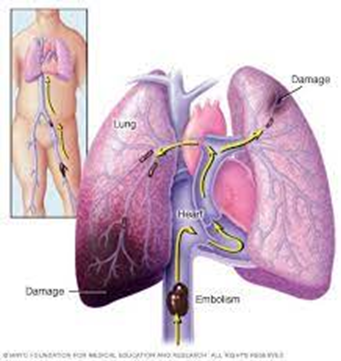Which of the following could the nurse expect to observe in an older adult client who has a pneumothorax?
Higher oxygen saturations of 98% to 99%
Lower oxygen saturations of 93% to 94%
Lower energy expenditure
Increased lung capacity
The Correct Answer is B
Choice A Reason:
Higher oxygen saturations of 98% to 99% is inappropriate. A pneumothorax involves the presence of air in the pleural space, which can compromise lung function and gas exchange. This compromised lung function typically leads to decreased oxygenation of the blood, resulting in lower oxygen saturations rather than higher saturations.
Choice B Reason:
Lower oxygen saturations of 93% to 94% is appropriate. A pneumothorax disrupts the normal exchange of oxygen and carbon dioxide in the lungs due to partial or complete lung collapse. As a result, the affected lung is unable to adequately oxygenate the blood, leading to lower oxygen saturations, which are indicative of hypoxemia.
Choice C Reason:
Lower energy expenditure is inappropriate. Energy expenditure is not typically affected by a pneumothorax. While the discomfort and respiratory distress associated with a pneumothorax may cause the individual to limit physical activity, there is no direct impact on overall energy expenditure.
Choice D Reason:
Increased lung capacity is inappropriate. A pneumothorax results in partial or complete collapse of the affected lung, reducing lung capacity rather than increasing it. The presence of air in the pleural space creates positive pressure, which can compress the lung and decrease its ability to expand fully during inhalation.
Nursing Test Bank
Naxlex Comprehensive Predictor Exams
Related Questions
Correct Answer is D
Explanation
Correct answer: D
Choice A Reason:
Decreased pulmonary vascular resistance is incorrect. Inflammatory mediators released in response to a pulmonary embolism can lead to vasoconstriction and increased pulmonary vascular resistance. This is part of the body's response to redirect blood flow away from the affected area of the lung and maintain adequate perfusion to other areas.
Choice B Reason:
Hypercapnia is incorrect. Hypercapnia refers to elevated levels of carbon dioxide (CO2) in the blood.Hypocapnia usually is present with embolism; hypercapnia, on the other hand, is rare.
Choice C Reason:
Hypoventilation is incorrect. Hypoventilation occurs when there is inadequate ventilation of the lungs relative to metabolic demands. In the context of a pulmonary embolism, hypoventilation can occur due to factors such as pain, respiratory muscle fatigue, or impaired gas exchange, all of which can be influenced by the release of inflammatory mediators.
Choice D Reason:
Respiratory alkalosis is correct.In response to the blockage and the resulting inflammation, the body often increases the respiratory rate as a compensatory mechanism to maintain adequate oxygen levels and remove carbon dioxide.Due to the increased breathing rate, there is excessive exhalation of carbon dioxide, leading to a decrease in the partial pressure of CO2 in the blood. This results in an increase in blood pH, causing respiratory alkalosis.

Correct Answer is ["A","B","D","E"]
Explanation
Choice A Reason:
Sexual intercourse is correct. Stimulation of the genitalia or other areas below the level of injury can trigger autonomic dysreflexia in individuals with spinal cord injuries.
Choice B Reason:
Tight clothing is correct. Any form of tight or restrictive clothing, including belts or waistbands, can stimulate the body below the level of injury and trigger autonomic dysreflexia.
Choice C Reason:
Nausea is incorrect. While nausea itself is not a common trigger for autonomic dysreflexia, it may occur as a result of the condition. Autonomic dysreflexia can cause a variety of symptoms, including nausea, due to the sudden increase in blood pressure.
Choice D Reason:
Surgery below the level of injury is correct. Surgical procedures performed below the level of the spinal cord injury can lead to stimulation of the body below the injury site, triggering autonomic dysreflexia.
Choice E Reason:
Urinary tract infections (UTIs) is correct. Infections of the urinary tract, especially those involving the bladder or urethra, can stimulate the body below the level of injury, leading to autonomic dysreflexia.
Whether you are a student looking to ace your exams or a practicing nurse seeking to enhance your expertise , our nursing education contents will empower you with the confidence and competence to make a difference in the lives of patients and become a respected leader in the healthcare field.
Visit Naxlex, invest in your future and unlock endless possibilities with our unparalleled nursing education contents today
Report Wrong Answer on the Current Question
Do you disagree with the answer? If yes, what is your expected answer? Explain.
Kindly be descriptive with the issue you are facing.
